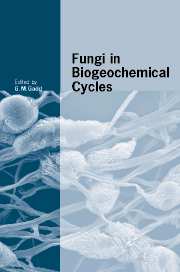Book contents
- Frontmatter
- Contents
- List of Contributors
- Preface
- 1 Geomicrobiology: relative roles of bacteria and fungi as geomicrobial agents
- 2 Integrated nutrient cycles in boreal forest ecosystems – the role of mycorrhizal fungi
- 3 Fungal roles in transport processes in soils
- 4 Water dynamics of mycorrhizas in arid soils
- 5 Integrating ectomycorrhizal fungi into quantitative frameworks of forest carbon and nitrogen cycling
- 6 Role of arbuscular mycorrhizal fungi in carbon and nutrient cycling in grassland
- 7 The role of wood decay fungi in the carbon and nitrogen dynamics of the forest floor
- 8 Relative roles of bacteria and fungi in polycyclic aromatic hydrocarbon biodegradation and bioremediation of contaminated soils
- 9 Biodegradation and biodeterioration of man-made polymeric materials
- 10 Fungal dissolution and transformation of minerals: significance for nutrient and metal mobility
- 11 Fungal activities in subaerial rock-inhabiting microbial communities
- 12 The oxalate–carbonate pathway in soil carbon storage: the role of fungi and oxalotrophic bacteria
- 13 Mineral tunnelling by fungi
- 14 Mineral dissolution by ectomycorrhizal fungi
- 15 Lichen biogeochemistry
- 16 Fungi in subterranean environments
- 17 The role of fungi in carbon and nitrogen cycles in freshwater ecosystems
- 18 Biogeochemical roles of fungi in marine and estuarine habitats
- Index
- References
11 - Fungal activities in subaerial rock-inhabiting microbial communities
Published online by Cambridge University Press: 10 December 2009
- Frontmatter
- Contents
- List of Contributors
- Preface
- 1 Geomicrobiology: relative roles of bacteria and fungi as geomicrobial agents
- 2 Integrated nutrient cycles in boreal forest ecosystems – the role of mycorrhizal fungi
- 3 Fungal roles in transport processes in soils
- 4 Water dynamics of mycorrhizas in arid soils
- 5 Integrating ectomycorrhizal fungi into quantitative frameworks of forest carbon and nitrogen cycling
- 6 Role of arbuscular mycorrhizal fungi in carbon and nutrient cycling in grassland
- 7 The role of wood decay fungi in the carbon and nitrogen dynamics of the forest floor
- 8 Relative roles of bacteria and fungi in polycyclic aromatic hydrocarbon biodegradation and bioremediation of contaminated soils
- 9 Biodegradation and biodeterioration of man-made polymeric materials
- 10 Fungal dissolution and transformation of minerals: significance for nutrient and metal mobility
- 11 Fungal activities in subaerial rock-inhabiting microbial communities
- 12 The oxalate–carbonate pathway in soil carbon storage: the role of fungi and oxalotrophic bacteria
- 13 Mineral tunnelling by fungi
- 14 Mineral dissolution by ectomycorrhizal fungi
- 15 Lichen biogeochemistry
- 16 Fungi in subterranean environments
- 17 The role of fungi in carbon and nitrogen cycles in freshwater ecosystems
- 18 Biogeochemical roles of fungi in marine and estuarine habitats
- Index
- References
Summary
Introduction
There were times on our planet when the barren dryness of uninhabited continents sharply contrasted with the densely populated sea. The continental lithosphere was then essentially represented by rock surfaces of different types. Sedimentary rocks were rare, if not absent. As rock materials became exposed to the subaerial environment at the Earth's surface, they encountered a whole range of environmental challenges such as temperature fluctuations, water, unbuffered cosmic and solar irradiation and atmospheric gases and solids instead of dissolved species. These influences resulted in rocks undergoing alterations in material properties leading to erosion and breakdown into ever-smaller particles and constituent minerals, formation of sandy sediments, and mineral soils (Ehrlich, 1996). Primordial terrestrial environments can therefore be visualized as a freshly exposed and only slightly physically pre-weathered rock surface.
However, physical and chemical changes in rock-forming minerals even during the very first stages of the terrestrial evolution were accompanied by an initially slow but steady establishment and spread of living organisms. Life started to colonize rock surfaces during the Archean. The first settlers were undoubtedly biofilms and later mature microbial mats not unlike modern desert or intertidal stromatolithic systems (Costerton & Stoodley, 2003). Environmental and geochemical settings of these ancient subaerial habitats were probably very similar to the conditions of present-day deserts. Rock surface environments were then, and remain now, exceptionally hostile with respect to all conditions necessary for the maintenance of living systems.
- Type
- Chapter
- Information
- Fungi in Biogeochemical Cycles , pp. 267 - 288Publisher: Cambridge University PressPrint publication year: 2006
References
- 6
- Cited by



